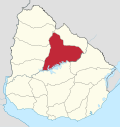Paso de los Toros
| Paso de los Toros | |
|---|---|
| City | |
|
Monument in El Toro Square | |
 Paso de los Toros Location in Uruguay | |
| Coordinates: 32°49′05″S 56°30′23″W / 32.81806°S 56.50639°WCoordinates: 32°49′05″S 56°30′23″W / 32.81806°S 56.50639°W | |
| Country |
|
| Department | Tacuarembó |
| Population (2011) | |
| • Total | 12,985 |
| • Demonym | isabelino |
| Time zone | UTC -3 |
| Postal code | 45100 |
| Dial plan | +598 4664 (+4 digits) |
Paso de los Toros (English: Bulls' Pass) is a city of the Tacuarembó Department in Uruguay.
Location
The city is located on the north bank of Río Negro and on Route 5, about 140 kilometres (87 mi) south-southwest of Tacuarembó, the capital of the department, and about 66 kilometres (41 mi) north of Durazno, the capital of Durazno Department.
History
The Midland Uruguay Railway began operation in 1889 with a line that ran between Paso de los Toros and Salto.[1] On 17 July 1903, the group of houses of the area known as Paso de los Toros was declared a "Pueblo" (village) named "Santa Isabel" and became head of the judicial section of the same name. On 27 November 1929 it was renamed to "Paso de los Toros" and its status was elevated to "Villa" (town) by the Act of Ley Nº 8.523.[2] On 1 July 1953, its status was further elevated to "Ciudad" (city) by the Act of Ley Nº 11.952.[3]
Climate
| Climate data for Paso de los Toros | |||||||||||||
|---|---|---|---|---|---|---|---|---|---|---|---|---|---|
| Month | Jan | Feb | Mar | Apr | May | Jun | Jul | Aug | Sep | Oct | Nov | Dec | Year |
| Record high °C (°F) | 42.8 (109) |
41.0 (105.8) |
38.6 (101.5) |
36.0 (96.8) |
32.3 (90.1) |
28.8 (83.8) |
30.3 (86.5) |
33.2 (91.8) |
35.5 (95.9) |
36.0 (96.8) |
39.5 (103.1) |
40.9 (105.6) |
42.8 (109) |
| Average high °C (°F) | 30.9 (87.6) |
29.4 (84.9) |
27.2 (81) |
23.3 (73.9) |
19.8 (67.6) |
16.4 (61.5) |
16.2 (61.2) |
17.7 (63.9) |
19.8 (67.6) |
22.8 (73) |
25.8 (78.4) |
29.1 (84.4) |
23.2 (73.8) |
| Daily mean °C (°F) | 24.6 (76.3) |
23.7 (74.7) |
21.6 (70.9) |
17.7 (63.9) |
14.6 (58.3) |
11.5 (52.7) |
11.4 (52.5) |
12.5 (54.5) |
14.3 (57.7) |
17.3 (63.1) |
20.0 (68) |
23.0 (73.4) |
17.7 (63.9) |
| Average low °C (°F) | 18.8 (65.8) |
18.4 (65.1) |
16.5 (61.7) |
12.7 (54.9) |
9.9 (49.8) |
7.0 (44.6) |
7.2 (45) |
7.8 (46) |
9.3 (48.7) |
12.1 (53.8) |
14.5 (58.1) |
17.2 (63) |
12.6 (54.7) |
| Record low °C (°F) | 7.6 (45.7) |
4.0 (39.2) |
4.6 (40.3) |
1.4 (34.5) |
−1.7 (28.9) |
−5.0 (23) |
−5.0 (23) |
−3.3 (26.1) |
−1.6 (29.1) |
0.4 (32.7) |
3.2 (37.8) |
6.3 (43.3) |
−5.0 (23) |
| Average precipitation mm (inches) | 121 (4.76) |
124 (4.88) |
125 (4.92) |
102 (4.02) |
103 (4.06) |
98 (3.86) |
112 (4.41) |
90 (3.54) |
97 (3.82) |
110 (4.33) |
108 (4.25) |
97 (3.82) |
1,287 (50.67) |
| Average precipitation days (≥ 1.0 mm) | 6 | 7 | 6 | 6 | 6 | 6 | 7 | 6 | 6 | 7 | 6 | 6 | 75 |
| Average relative humidity (%) | 65 | 70 | 73 | 77 | 80 | 82 | 82 | 78 | 76 | 73 | 70 | 65 | 74 |
| Mean monthly sunshine hours | 288.0 | 213.8 | 227.6 | 187.5 | 166.1 | 127.4 | 144.0 | 169.0 | 181.3 | 224.5 | 239.8 | 287.2 | 2,456.2 |
| Source: Dirección Nacional de Meteorología (extremes 1937–1994)[4][5] | |||||||||||||
Population
In 2011, Paso de los Toros had a population of 12,985,[6] which makes it the second largest city in the department, after the capital city of Tacuarembó.
| Year | Population |
|---|---|
| 1908 | 4,963 |
| 1963 | 11,359 |
| 1975 | 13,032 |
| 1985 | 13,026 |
| 1996 | 13,315 |
| 2004 | 13,231 |
| 2011 | 12,985 |
Source: Instituto Nacional de Estadística de Uruguay[2]
Places of worship
Soft drink
In Uruguay, Pepsi manufactures a Paso de los Toros soft drink named after the city.
Noted local people
- Fabián O'Neill: football player
- Mario Benedetti: writer
- Nelson Acosta: football manager
- Víctor Púa: football manager
- Waldemar Rial: basketball player
References
- ↑ "AFE / Historia / Las Companias". Administración de Ferrocarriles del Estado (AFE). Retrieved 6 September 2012.
- 1 2 "Statistics of urban localities (1908–2004) (see also "Santa Isabel")" (PDF). INE. 2012. Retrieved 6 September 2012.
- ↑ "LEY N° 11.952". República Oriental del Uruguay, Poder Legislativo. 1953. Retrieved 6 September 2012.
- ↑ "Estadísticas climatológicas" (in Spanish). Dirección Nacional de Meteorología. Retrieved 28 September 2016.
- ↑ "RECORDS METEOROLOGICOS EN EL URUGUAY" (in Spanish). Dirección Nacional de Meteorología. Retrieved 28 September 2016.
- ↑ "Censos 2011 Cuadros Tacuarembó". INE. 2012. Retrieved 25 August 2012.

